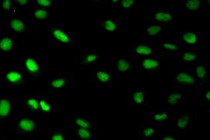ARG59903
anti-RFC1 antibody
anti-RFC1 antibody for ICC/IF,Western blot and Human,Mouse,Rat
Overview
| Product Description | Rabbit Polyclonal antibody recognizes RFC1 |
|---|---|
| Tested Reactivity | Hu, Ms, Rat |
| Tested Application | ICC/IF, WB |
| Host | Rabbit |
| Clonality | Polyclonal |
| Isotype | IgG |
| Target Name | RFC1 |
| Antigen Species | Human |
| Immunogen | Recombinant fusion protein corresponding to aa. 400-700 of Human RFC1 (NP_001191676.1). |
| Conjugation | Un-conjugated |
| Alternate Names | Activator 1 subunit 1; RFC; Replication factor C large subunit; PO-GA; DNA-binding protein PO-GA; RF-C 140 kDa subunit; Replication factor C subunit 1; A1; RFC140; RECC1; Activator 1 large subunit; Replication factor C 140 kDa subunit; A1 140 kDa subunit; Activator 1 140 kDa subunit; MHCBFB |
Application Instructions
| Application Suggestion |
|
||||||
|---|---|---|---|---|---|---|---|
| Application Note | * The dilutions indicate recommended starting dilutions and the optimal dilutions or concentrations should be determined by the scientist. | ||||||
| Positive Control | MCF7 | ||||||
| Observed Size | 130 kDa |
Properties
| Form | Liquid |
|---|---|
| Purification | Affinity purified. |
| Buffer | PBS (pH 7.3), 0.02% Sodium azide and 50% Glycerol. |
| Preservative | 0.02% Sodium azide |
| Stabilizer | 50% Glycerol |
| Storage Instruction | For continuous use, store undiluted antibody at 2-8°C for up to a week. For long-term storage, aliquot and store at -20°C. Storage in frost free freezers is not recommended. Avoid repeated freeze/thaw cycles. Suggest spin the vial prior to opening. The antibody solution should be gently mixed before use. |
| Note | For laboratory research only, not for drug, diagnostic or other use. |
Bioinformation
| Database Links | |
|---|---|
| Gene Symbol | RFC1 |
| Gene Full Name | replication factor C (activator 1) 1, 145kDa |
| Background | This gene encodes the large subunit of replication factor C, a five subunit DNA polymerase accessory protein, which is a DNA-dependent ATPase required for eukaryotic DNA replication and repair. The large subunit acts as an activator of DNA polymerases, binds to the 3' end of primers, and promotes coordinated synthesis of both strands. It may also have a role in telomere stability. Alternatively spliced transcript variants encoding different isoforms have been noted for this gene. [provided by RefSeq, Mar 2011] |
| Function | The elongation of primed DNA templates by DNA polymerase delta and epsilon requires the action of the accessory proteins PCNA and activator 1. This subunit binds to the primer-template junction. Binds the PO-B transcription element as well as other GA rich DNA sequences. Could play a role in DNA transcription regulation as well as DNA replication and/or repair. Can bind single- or double-stranded DNA. Interacts with C-terminus of PCNA. 5' phosphate residue is required for binding of the N-terminal DNA-binding domain to duplex DNA, suggesting a role in recognition of non-primer template DNA structures during replication and/or repair. [UniProt] |
| Cellular Localization | Nucleus. [UniProt] |
| Calculated MW | 128 kDa |
Images (3) Click the Picture to Zoom In
-
ARG59903 anti-RFC1 antibody ICC/IF image
Immunofluorescence: A549 cells stained with ARG59903 anti-RFC1 antibody.
-
ARG59903 anti-RFC1 antibody WB image
Western blot: 25 µg of MCF7 cell lysate stained with ARG59903 anti-RFC1 antibody at 1:500 dilution.
-
ARG59903 anti-RFC1 antibody ICC/IF image
Immunofluorescence: MCF7 cells stained with ARG59903 anti-RFC1 antibody.








